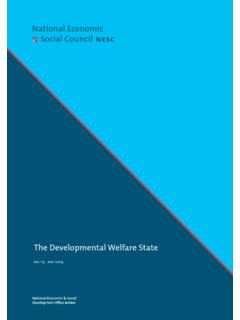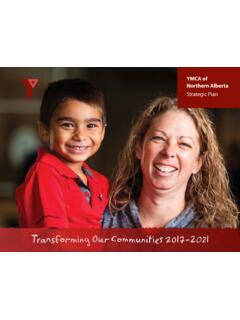Transcription of Updated National Action Plan for Social Inclusion …
1 UpdatedNational Action plan for Social Inclusion 2015- 2017 An Roinn Coimirce S isiala Department of Social National Action plan for Social Inclusion 2015 2017 Updated National Action plan for Social Inclusion 2015- 2017 This Publication is available online in English and Irish at and The Updated National Action plan for Social Inclusion sets out the Government decision to revise and enhance the National Social target for poverty reduction, arising from the review of the National poverty target. Published by: Department of Social Protection Gandon House, Amiens Street Dublin 1 ISBN: 978-1-908109-36-1 Department of Social Protection 2016 Dublin, Ireland, February 2016 1 Updated National Action plan for Social Inclusion 2015 2017 Updating the National Action plan for Social Inclusion The National Action plan for Social Inclusion 2007 2016 (NAPinclusion) identifies a wide range of targeted actions and interventions to achieve the overall objective of reducing consistent poverty.
2 The plan prioritises 12 high level goals and identifies up to 150 actions across Departments and agencies with a remit in Social policy, as part of a strategic approach to make a decisive impact on poverty over the period to 2016. The Irish Government first introduced a National Anti-Poverty Strategy (NAPS) entitled Sharing in Progress, 1997-2007, designed to ensure that those experiencing poverty and Social exclusion would share in the fruits of the economic development being achieved at that time, and to make a major impact on combating poverty. This Strategy subsequently lead to the development of the National Action plan for Social Inclusion in 2007. Implementation of NAPinclusion has been actively monitored over its duration via the annual Social Inclusion Report. This is one of the formal monitoring and reporting mechanisms set out in the plan .
3 Preparation and compilation of the report is coordinated by the Department of Social Protection, with input from relevant Government Departments. To date five such reports have been prepared for Government, covering the periods 2007, 2008, 2009-2010, 2011-2012 and 2013-2014 respectivelyi. Need for Updating Since 2008, Ireland has experienced a major economic recession complicated by banking and fiscal crises. It is clear that the challenges facing the country are now very different to when NAPinclusion was drawn up in 2007. Similarly, the Government s response to combating poverty has adjusted. There is now a greater focus on modernising the Social protection system, improving effectiveness and efficiency of Social transfers and strengthening active Inclusion policies. Furthermore, new strategies have emerged, or are being developed, which are not adequately reflected in NAPinclusion.
4 As a result of such dynamic in economic, Social and political contexts, certain NAPinclusion goals and actions became out of date or less relevant. Current priorities and policies indicated that updating of NAPinclusion for its remaining two years 2015-2016 was required. This updating process was carried out as a transitional measure pending a full review of NAPinclusion in 2017 . Extending the Timeframe In addition to the required updating, the timeframe of NAPinclusion is being extended by one year, to 2017 for the following reasons: To coincide with the interim National Social Target for Poverty Reduction in 2016. It is expected that the results of the CSO SILC 2016 will be published in late 2017 . To bring NAPinclusion in line with all stakeholder departments Statements of Strategy, which cover the period 2015- 2017 .
5 To acknowledge 2017 as the 20th anniversary of Ireland s first National poverty strategy and poverty target in 1997. Consultations on future NAPinclusion strategy beyond 2017 could be framed around this landmark anniversary. i See for Social Inclusion Reports 2 Updated National Action plan for Social Inclusion 2015 2017 Updating Process The Social Inclusion Divisionii in the Department of Social Protection conducted a focused updating of NAPinclusion to cover an extended 2015- 2017 timeframe. Government Departments that have responsibility for delivering the programme of goals and actions set out in the plan were consulted. Each Department was invited to indicate how the high level goals might be reformulated to better reflect the current issues and interventions to tackle poverty and Social exclusion. In addition, the 2015 Social Inclusion Forum featured a consultation with community and voluntary groups on the current poverty challenges and the key priorities for the period 2015- 2017 .
6 Building an Inclusive Recovery The links between work and poverty are well-established; employment is critical as a route out of poverty. Creating inclusive labour markets is an important element in addressing the needs of those furthest from the labour market and with the highest poverty risk. This is recognised in the Medium-Term Economic Strategy 2014-2020: The Government s purpose is to ensure a job rich recovery and to set Ireland on the path to sustainable prosperity, which will provide jobs and opportunity for our people, provide high quality public services and encourage innovation in business and across society. This will enable the building of a fairer Ireland by helping to reduce inequality and improve poverty outcomes across society, with a particular emphasis on child poverty in line with the Programme for Government (p 15).
7 Iii Ireland faces a number of challenges in addressing unemployment and high poverty risks, particularly for the long-term unemployed, families (especially lone parent families) and jobless households. It is also important to consider the gender dimension, not only in terms of female labour market participation and work-life balance, but also in terms of positive outcomes for individuals and for their children. Ireland is recovering from an unprecedented economic crisis that engulfed the country in recent years. Evidence of an economic recovery continues to emerge. Financial stability has been restored with public finances returned to a sustainable path. The country has exited from the EU-IMF bailout programme and delivered a return to job creation and economic growth. As the country is moving in the right direction, the Government has set a further priority to broaden and deepen this economic recovery in a manner that is felt in the daily lives of individuals, families and communities across the country, so that the ongoing programme of economic repair will now be accompanied by an equal emphasis on Social recovery and improved living and working standards.
8 Ii The Social Inclusion Division has a central role in co-ordinating the ongoing development of the Government s National Action plan for Social Inclusion 2007 2016 iii Government of Ireland (2013) a Strategy for Growth: Medium-Term Economic Strategy 2014-2020. Dublin: Government Stationery Office. 3 Updated National Action plan for Social Inclusion 2015 2017 The Statement of Government Priorities 2014-2016 offers a roadmap on how working families and low and middle income workers will be supported to ensure the dividend of recovery is felt everywhere. This will be achieved through various priorities including: Reduction of tax rates for low- and middle- income earners to be delivered over a number of budgets, which will also help promote more job creation and improve Ireland s attractiveness as a location of investment.
9 Establishment of a Low Pay Commission to make recommendations on the minimum wage to Government, based on consultation and evidence. Introduction of measures to assist low income families by improving the system of child income supports such that those moving from welfare to work will retain payments for children to ensure that people are better off in work. Increased access to subsidised childcare and after school places by extending eligibility and rebalancing parental contributions for families making their way into employment. The Social Impact Assessment of the welfare and income tax measures in Budget 2016iv found that households with children are the biggest beneficiaries of the Budget, including working lone parents and unemployed couples with Active Inclusion Strategy The overall strategy for active Inclusion is set out in the National Reform Programme 2011 and is framed around the developmental welfare state , as outlined in NAPinclusion.
10 Active Inclusion means enabling every citizen, notably the most disadvantaged, to fully participate in society, including having a job. Active Inclusion is intended to tackle various challenges including: poverty, Social exclusion, in-work poverty, labour market segregation, long-term unemployment and gender has three main policy components: Adequate minimum income: provision of adequate income support. This could be by linking out-of-work and in-work benefits, and by helping people to access the benefits they are entitled to. Inclusive labour markets: making it easier for people to join the workforce, tackling in-work poverty, avoiding poverty traps and disincentives to work. Access to quality services: helping people participate actively in society, by accessing quality services Social protection through the provision of income support payments as well as access to employment and related services is central to the promotion of active Inclusion .




